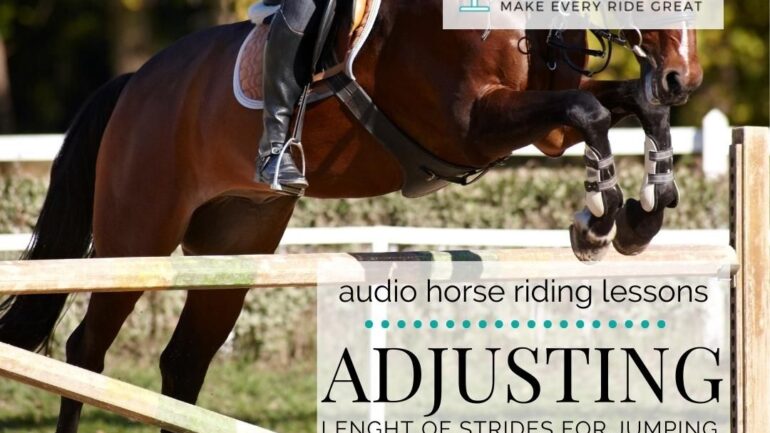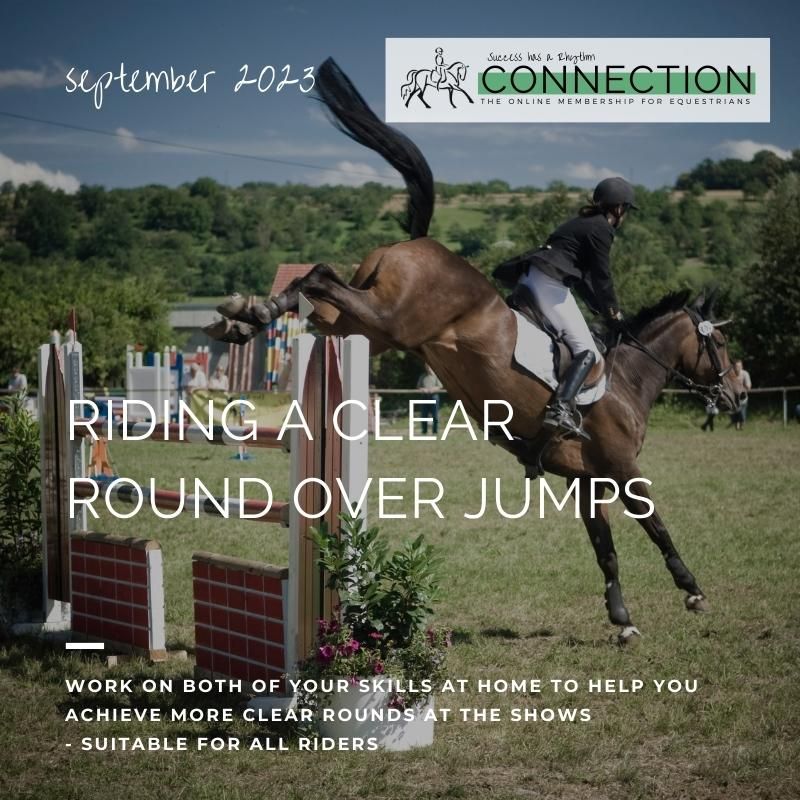If you enjoy jumping with your horse, riding that clear round is all important. Luckily there are a few key areas you can work on in your training that will help you to begin seeing more of them. Adjusting the length of your horse’s strides is just one of those. And it’s also a pretty useful exercise for all horses and riders, jumping or not.
If you can begin to intentionally help your horse to have either a shorter or a longer stride, it gives you both flexibility and adjustability in your riding
In this episode of the Daily Strides Podcast, I want to help you to begin to understand just how versatile this exercise is to have in your toolkit when it comes to riding your horse.
Predicting Your Horses ‘Arrival’ Point
Like anything, if you can more accurately predict the outcome of something, you can begin to make changes or preparations for how it will be. Jumping is no different. When you can begin to ‘see’ the point your horse will actually take off from the fence, from a distance away, you can make decisions based on that.
In fact, being able to see a ‘point’ for something to happen further on down the line is useful regardless of what you’re doing with your horse.
And when jumping, remember, that all horses are different. So when we think about jumping tracks the distances, however well planned, won’t suit all horses. However, if you can accurately predict where your horse will be 5 or 6 strides from now, and then make adjustments to those 5 or 6 strides; well it won’t really matter, will it?
Before Adjusting the Length of Your Horse’s Strides
Like most things, there are a couple of prerequisites that riders and horses will have to develop before they begin adding this to their training program. The first of these, I feel, is the ability to see and then ride a line. This is often one of those ‘easier said than done’ things.
And while many riders might be able to ‘see’ the line; riding it is a whole other story!
Another important element to both understand and effectively ride is the half halt. Having control over your aids to clearly communicate this to your horse is key to it working for you. Whether that is to balance, rebalance, correct, or just focus attention and energy.
Adjusting the length of your horse’s strides is not pulling their mouth or kicking on; it is harnessing the energy to make changes to your horse’s way of going.
Understanding Impulsion
Whether you’re shortening or lengthening, maintaining the desired level of impulsion is key to effectively jumping the actual jump! Pulling too much and slowing things down in a misguided attempt to shorten will not work. Sure, you might fit more strides in between here and there. But when you do get ‘there’ your horse won’t be ready to actually jump the jump. Which, is the whole point of the process.
Similarly, kicking on and chasing your horse to lengthen will result in your horse flattening and becoming heavy on the forehand; again not a great way to meet a jump!
Impulsion needs you to really have the correct level of tension present inside of the container that makes up you and your horse. This tension (relaxation) combined with the actual energy needed (forwardness) and a good and consistent rhythm will help maintain impulsion. And, when working correctly, impulsion leads to straightness. Another key element when jumping those clear rounds.
Seeing a Stride
This is a skill that, as a rider, needs to be developed in order to really get the benefits of adjusting the length of your horse’s strides. After all, it makes little sense adjusting them if you’ve no idea where you really want to be at take-off!
Seeing a stride simply means that you can accurately predict where your horse will be in a specific number of strides time.
It’s being able to say, “in 5 strides from now, all being equal to what we’re doing now, we will be ‘there’.” And based on where ‘there’ is, you can then decide if adjustments need to be made to the actual length of the strides. Changing the length of the stride will prevent chipping in or standing off the jump. Neither of these are ideal for clear rounds!
If ‘there’ is too close or too far away from the ideal take-off point of the jump, you have now 5 strides available to adjust that point. And this is often the difference between a pole staying up or coming down.
Counting Yourself Down
Start learning how to see your stride by playing a game with yourself over a single pole on the ground. Canter back and forth over the pole and see if you can accurately and correctly predict the point where you will have 3 strides left to go before ‘jumping’ the pole.
Accountability is key here; say out loud 3, 2, 1, jump. If you get 3, 2, jump or 3, 2, 1, 1, 1, jump – clearly there’s an issue!
Once you have eventually mastered this skill, you can begin to make it a little more difficult. Begin predicting where 5 strides between you and the pole will be. Again, count yourself down. Counting yourself ‘up’ (1,2,3,4,5) won’t work as you can just keep counting! I also find that riders who initially count in their heads also struggle! Their brain wants them to be right, so they can tend to tell themselves porkies!
When you can accurately predict the point where your horse will fit 5 or even 7 strides in between you and the pole, this is where you can start to see where adjustments should be made. And, this is where you can begin working on making those small adjustments over every stride to result in a big difference.
Shortening Your Strides
If you can take 2 inches off each of your 5 strides, it means you can change the ‘take-off point’ by 10 inches. That is nearly a foot or 30 centimeters. And that is just shortening by the smallest of margins, 2 inches or 5 centimeters.
Imagine when you and your horse develop this skill; you can shorten strides by 10 inches per stride (or more). This will truly give you the flexibility you need to meet each jump at the right place each time. So that your horse has the best possible chance of clearing the jump.
Shortening is not slowing your horse down. It is not pulling his mouth or throwing an ‘anchor’ behind you in the sand!
True shortening will allow you to maintain the energy, rhythm, suppleness, impulsion, contact, and straightness in order to reach the jump in the best possible place to clear it from. Sometimes, when we shorten, your horse might not initially have enough strength in his body to maintain the above; this is where your aids will act like boundaries to help your horse.
Shortening the strides also requires that you maintain a lightness in both how you are riding and your horse’s way of going. Light and bouncy; not heavy and ‘stuck in the mud’.
Lengthening the Strides
So many riders think lengthening and speed are related. I have honestly watched people and said silent prayers in my head that they get from A to B in one piece! It can be nerve-wracking watching a rider who has confused rushing or chasing with lengthening.
To effectively lengthen the stride, you must maintain the energy, the tension, the contact, the forwardness, and – maybe most importantly – the impulsion.
Chasing your horse on to the point where all of the energy falls out the front door is not lengthening. In fact, it is just downright dangerous as your horse will find it very difficult to find the ‘lift off’ gear and get his shoulders over the jump!
As you ask for your horse to lengthen, make sure you’re not getting ahead of or in front of the movement. If you are leaning your weight in any way on your horse’s shoulders or withers, you make jumping the jump so much more difficult for the horse. Sit up and remember to ride!
Adjusting the Length of Your Horse’s Stride
My big piece of advice when you are beginning to work with adjusting the length of your horse’s stride is to start small. A couple of inches either way are either longer or shorter. Being able to have this level of adjustability in your horse can change so much when it comes to your training in general.
Remember, you are simply ‘asking’ your horse to lengthen or shorten; you’re not doing the work yourself! Don’t lie back and don’t throw your body forward.
And, as I said at the beginning, this type of suppleness and adjustability through your horse is not just for jumping. You can and will use this in all day-to-day riding. And it’s a great exercise to work on with your horse as well.
Happy Riding
Lorna


